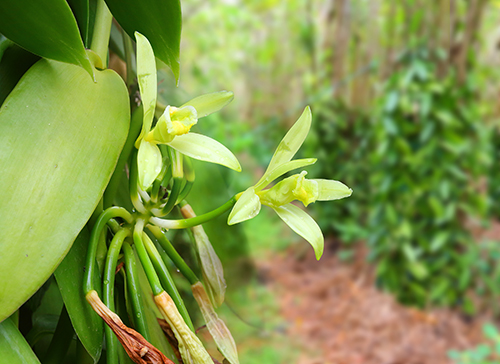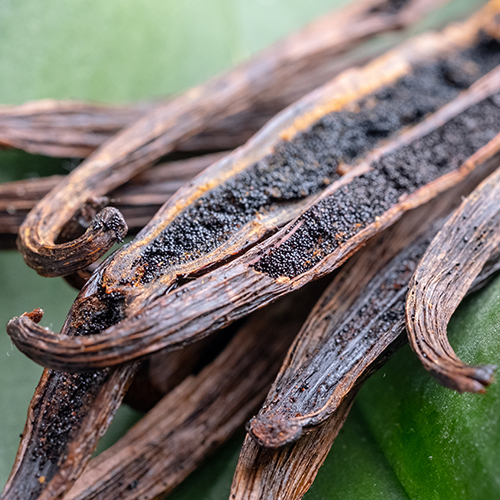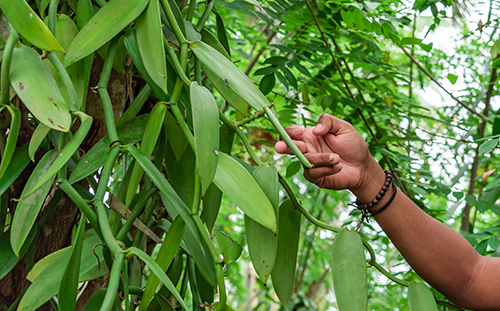
The Not-So-Plain Story of Vanilla and Elo’s Efforts to Revitalize the Industry

Most of us never consider where we get vanilla, that ubiquitous flavor found in everything from ice cream to over-the-counter medicines.
Elo Life Systems does. The Durham food and agriculture company is applying the power of genomics to improve the plant that supplies the most widely used extract in the consumer products industry.
And it’s none too soon for the long list of multinational companies that use vanilla – close to 18,000 products contain natural or artificial vanilla flavoring. Or for farmers in some of the poorest countries in the world who count on the crop to feed their families.
The problem is that vanilla farming hasn’t changed much since the vanilla bean was first domesticated in Mexico during the Aztec Empire era. We’re talking about the 15th century.
Over the years, production has migrated to diverse regions around the world. Today most vanilla comes from Madagascar, and to a lesser extent Indonesia, Mexico, Uganda, India and a handful of other countries.

The vanilla supply chain has traditionally been plagued by a multitude of shortcomings. Among them a lack of innovation, wide fluctuations in crop output, price volatility, fungal disease and productivity issues. These factors threaten the sustainability and profitability of vanilla and the financial stability of those who grow it.
Elo scientists thought this was a global challenge well worth tackling. So they developed a high-resolution genomic sequence of the vanilla plant that provides a blueprint for improving its quality, resilience and yield. Elo had help from Alan Chambers, Ph.D., of the Tropical Research and Extension Center at the University of Florida. He’s a leading authority on the biology of vanilla.
“Our experience with a variety of different crops – and our knowledge of genomics-based technologies – have enabled us to find solutions to difficult global challenges like sustainable vanilla production,” said Elo CEO Fayaz Khazi, Ph.D., in an interview with the North Carolina Biotechnology Center.
“Insights from this highly detailed sequence of the vanilla genome allow us to take the first significant step toward improving the livelihoods of smallholder farmers in vanilla-producing regions.”
Making a better bean through genomics
Khazi said Elo used its proprietary computational biology pipeline to identify the genetic factors that can improve the vanilla orchid. The data also introduce groundbreaking ways to produce more vanilla with less labor.

If you know anything about growing these plants, you know that labor is a major consideration.
The orchids that create vanilla beans originally were pollinated by a species of bees native to Mexico, where the plant got its start. But that changed when vanilla made its way to other parts of the world. In the absence of the only bee capable of fertilizing the vanilla plant, hand pollination became a commercial necessity.
Today vanilla orchid vines grow mostly in remote tropical areas where the hot, humid climate promotes their development. Farmers in Madagascar produce more than 80% of the global supply – projected to have an annual value of $4.3 billion by 2025.
Growers spend months closely monitoring the orchid vines for flowers. When an orchid blooms, they rush to hand-pollinate it. The blooms last for only a few hours each growing season. And if farmers miss their window of opportunity the plant won’t produce vanilla beans.
Mature beans are collected every day as they ripen. Each is touched by human hands hundreds of times during the slow, arduous journey from field to farmers market. No part of the process is mechanized.
Elo’s genomic mapping has opened the door to breeding a vanilla orchid structurally capable of pollinating itself. That has the potential to remove one of the most labor-intensive steps and to fundamentally change vanilla production.
Stabilizing the production and price of vanilla
The hands-on attention required to grow and harvest vanilla makes it the most expensive spice after saffron, also a flower byproduct. And the variation in vanilla yield and quality can result in wild and frequent price swings.
This infamous year of 2020, for example, terrible weather in Madagascar caused the value of vanilla beans to soar to $600 per kilogram (about 2.2 pounds). That’s 10 times higher than a few years ago.

Add to the equation a growing consumer preference for natural food additives, which is driving major companies like General Mills and Hershey’s to use vanilla beans – rather than artificial flavoring – in more of their products.
These factors affect the pocketbooks of smallholder farmers whose lives and livelihoods rise and fall on the vacillations of the vanilla bean. It can be a “feast or famine” existence – thriving one year and struggling to feed your family the next.
By analyzing the genetic makeup of the vanilla orchid, Elo has found ways to increase production and improve flavor while making the plant less prone to disease and better able to withstand difficult growing seasons. That can have a stabilizing influence on the vanilla market.
With a better understanding of the plant’s genomics, it may also be possible to expand the number of vanilla-growing regions to accommodate upswings in demand.
In an effort to promote innovation and stability in the industry, Elo has taken the unusual step of sharing its genomics data in this month’s edition of the online research journal, Nature Food. The company also is discussing, with several food and ingredient companies, ways to translate the knowledge gained from mapping the vanilla genome into improved varieties of vanilla.
“We have a real opportunity to drive overdue and meaningful change in the production of vanilla,” Khazi explained. “Our research can potentially help redefine the vanilla supply chain to benefit farmers, the companies that buy their product, and consumers. Those are goals well worth pursuing.”
About Elo Life Systems
Elo Life Systems’ mission is “to create food products that improve the health of people and the planet.” The company is a wholly owned subsidiary of Durham-based Precision BioSciences, Inc..

Since it was spun out of Duke University in 2006, Precision raised about $300 million in venture capital, government grants and collaboration agreements. The company went public in March 2019, grossing $145.4 million in an initial public offering of stock.
The fast-growing company’s shares are listed on the Nasdaq Global Select Market under the ticker symbol “DTIL,” shorthand for the company’s marketing tagline, “Dedicated to improving life.”
Elo forms partnerships with leading food companies to develop products that bridge gaps in productivity, nutritional demand, food security, climate resilience and human wellness.
It currently is working with the Dole Food Company to grow disease resistant bananas, and with other partners in the food and beverage industry to develop a natural zero-calorie sweetener from watermelon, and climate-smart plant-based proteins. The company also is collaborating with Ashland Corporation subsidiary Avoca in North Carolina to produce natural and sustainable fragrances.
